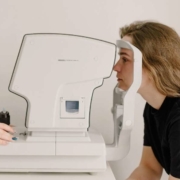Astigmatism: Causes, Symptoms, and Treatments
Medically Reviewed By Dr. Anthony Nappi / Published June 14, 2022 / 8 min. read

Did you know that one out of three people has astigmatism to some degree? Some people may not even know that they have this problem, especially if the astigmatism is mild. On the other hand, a more severe case of this condition can cause much more serious vision problems.
Thankfully, astigmatism is also very treatable. The trouble is rooted in the shape of the cornea. As long as you can adjust the shape or treat it, you should be able to see better. Keep reading and learn about astigmatism symptoms, how to know if you have this condition, and how it can be treated.
Astigmatism Explained
Astigmatism is a common eye condition caused by an imperfection in the eye’s curvature, specifically the cornea.
The cornea is the clear part of your eye. It is at the surface of your eye and is essential for protecting the inner structures of your eyeball. Without it, your eye would be susceptible to dirt, bacteria, and other contaminants.
The cornea is also responsible for filtering some of the sun’s UV rays. In general, the cornea is dome-shaped. However, astigmatism makes it, so the shape of the cornea isn’t round but more oval-shaped.
This may not seem like a big deal, but any slight change to the shape of the cornea can change the way light filters through it. As a result, light traveling through the cornea into the deeper structures of the eye will become distorted. As a result, what you see will also be distorted and not true to reality.
This can make it hard to see. Nearsightedness and farsightedness are both problems that could occur due to this condition. Nearsightedness, as the name suggests, means that you can see objects that are close to you without any problem.
However, objects that are farther away are blurry. The opposite is true with farsightedness. However, you should remember that there is not just one type of astigmatism.
In this guide to astigmatism, you will find that there are two main types: corneal and lenticular. We have already described the corneal variant, which has to do with the shape of the cornea. However, the lenticular shape has to do with the lens being misshapen.
Types of Astigmatism: What You Need to Know
There are also regular and irregular astigmatism types. Irregular astigmatism is not very common and involves the eyeball not being completely round. In this case, the irregular shape of the eye continues around the eyeball.
On the other hand, regular astigmatism involves the eyeball being evenly misshapen. Both of these types result in blurry vision. This is because whenever there is a distortion in the shape of the eye, whether it be the eye itself or a structure within the eye, external light will not be able to filter through the eye’s structures correctly.
In particular, the light will not be able to focus on the retina directly. The retina is the tissue on the back of the eyeball. It is rich in nerves that connect it to the brain.
If the light cannot focus clearly on the retina’s macula (as with astigmatism), the retina’s information will be a bit unclear as it sends the information to the brain. As a result, the final image that the eye registers will not be clear but fuzzy.
Common Causes of Astigmatism
Researchers are not yet sure what exactly causes astigmatism. However, genetics likely plays a large part.
Genetics
Many people are born with astigmatism and some are diagnosed with it later in life.
If certain members of your immediate family already have astigmatism, you may be at a higher risk of developing it. Even if your family doesn’t have astigmatism but has other eye disorders, you may still be more likely to develop astigmatism.
Eye Trauma
On the other hand, some people develop this condition much later in life. Astigmatism may also occur if there is any kind of trauma to the eye. For example, if you get hit in the eye with something, this blow may deform the cornea or the eye itself and result in astigmatism.
Previous Eye Surgery
If you have had eye surgery in the past, such as cataract surgery, you may develop astigmatism at some point later in your life. The symptoms of this condition are quite obvious. They involve blurry vision, eye irritation, squinting, and difficulty seeing in low light.
If you have any of these symptoms, it is a good idea to see an astigmatism specialist, such as an ophthalmologist and get an official diagnosis.
How Astigmatism is Diagnosed
An astigmatism test is a simple procedure. Usually, your doctor will put you through several vision tests to ensure that you have astigmatism and not another eye condition.
For example, a visual acuity assessment test involves reading small letters from a chart placed 20 feet away from you. This will test how far you can see. Keratometry is another test that consists in measuring the curve of your cornea.
Once the doctor finds that you have astigmatism, there will be several treatment options that you can consider. You can technically leave your astigmatism untreated, which may interfere with your daily life. Being unable to see clearly can make it challenging to do certain types of work. Depending on the severity of your astigmatism, you may be unable to drive, or driving may be particularly dangerous.
Astigmatism Treatment Options
When it comes to astigmatism treatments, there are options for every budget. The most common way to treat astigmatism is with corrective lenses.
Eyeglasses
Eyeglasses are the least invasive way to treat this problem.
For that reason, many doctors recommend eyeglasses as the first line of treatment. Most people prefer to get eyeglasses rather than pursue other treatment options because eyeglasses work pretty well and are much more affordable than other treatment options. You will need a special prescription to treat your particular type of astigmatism.
If you don’t like the idea of wearing glasses, there are also special contact lenses you can wear. Because astigmatism involves a physical curvature issue of your eyes, you won’t be able to wear any old contact lenses. Instead, you will need Orthokeratology (Ortho-K).
Ortho-K Contact Lenses
Ortho-K uses very rigid contact lenses. These lenses must be rigid enough to correct the curvature of your eye. Wearing these lenses for an extended period of time can temporarily restore the shape of your eye.
As a result, you’ll see clearly without the lenses. However, wearing the lenses is necessary or your vision will eventually return to how it was before the treatment. Ortho-K contacts are not as uncomfortable as you might think. Many people like to sleep with them in. That way, they can take them out and see better during the day.
Refractive Laser Surgery
Finally, the last treatment option involves surgery.
Most people with astigmatism don’t opt for surgery because it is invasive. However, if your case of astigmatism is very severe, your doctor may recommend laser eye surgery as a valid option. This kind of surgery involves lasers and is called LASIK.
In particular, the LASIK surgeon will use a laser on the cornea and reshape it so light can pass through it more effectively. In most cases, LASIK can correct astigmatism. Surgery, of course, comes with several risks.
For that reason, you will want to discuss the details of astigmatism surgery with your doctor to ensure that it’s the right treatment option for you.
Who Treats Astigmatism?
Astigmatism can be frustrating to deal with because it can make your daily life more difficult.
Astigmatism needs to be diagnosed and managed by an optometrist or ophthalmologist. An optometrist will treat your astigmatism by managing your prescription by performing regular comprehensive eye exams. He will prescribe you the lenses or contacts at the correct prescription. Your optometrist may also qualify you for LASIK eye surgery as a possible permanent solution.
Are you looking for specialists near you who can treat your astigmatism? If you live in Arizona, the eye doctors at BDP are experts in eye care and specialists in vision correction surgery. The Barnet Dulaney Perkins Vision Correction locations are in Scottsdale, Phoenix, Tucson, and Flagstaff. We offer free LASIK consultations. All BDP Eye Care Centers across Arizona can help treat and manage your astigmatism in many ways, such as with eyeglasses, contact lenses, and refractive surgery.
To learn more about treating your astigmatism, contact us here. We would love to see you see how we can help you enjoy life in focus.


 iStock
iStock iStock
iStock iStock
iStock

 iStock
iStock iStock
iStock